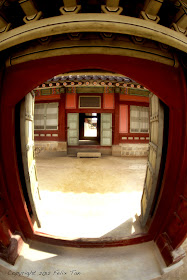Our last day in Seoul was marked with a must-see visit to the historical Gyeongbokgung Palace. Built by the founder of the Joseon dynasty - King Taejo - this is the grandest palace structure in the whole of Seoul. Burnt down by Japanese invasions in the 16th century, this palace laid in ruins for some 300 years before it was rebuilt in the late 19th century. Since the fall of the dynasty, this massive architectural feat has become the home of the National Folk Museum and the National Palace Museum, with one of the inner palaces transformed as the offices of the President.
.jpg) |
| Entrance of the Gyeonbokgung Palace |
It takes about an hour walk around the palace grounds to really appreciate the beauty of this once-glorious palace and imagine the occupants that lived in this compound. For those who are waiting to re-live the days of a time long gone, fret no more as there are performances to showcase the 'changing of guards' that are obviously catered to tourists. Performative to say the least, but it surely give a glimpse of the past. Otherwise, the only other time we get a chance to view such a 'life' would be through the numerous Korean period drama that is taking the world by storm [i.e.
무신 (soldier); 해를 품은 달 (Haereul Poomeun Dal or The Moon That Embraces the Sun); 타임슬립 닥터 진 (Time Slip Dr. Jin); or even 왕의 남자 (Wang-ui namja or The King's Man)]
.jpg) |
| The 'changing of guards' ceremony with traditional costumes; musical instruments and weapons to simulate actual scenarios |
.jpg) |
| A walk around the palace grounds |
.jpg) |
| A performance hall to celebrate visiting dignitaries and/or other folk traditions |
.jpg) |
| Doorway to the many rooms found around the compound |
.jpg) |
| These urns were used to contain food preservatives, that were eventually used in making Kimchi and other foodstuffs |
After about an hour of walking around the Gyeongbokgung Palace (Palace of Shining Happiness) and seeing the sights and knowing just a little more about this historic place, we reached one of the many exits. Security was tight around this area as the Cheongwadae (or Blue House), which is the official residential and office of the South Korean President, is just behind the Gyeongbokgung Palace where we all now stood.
Indeed, it was a little journey back in time that was most certainly memorable.
Photos and text by Felix Tan
.jpg)
.jpg)
.jpg)
.jpg)
.jpg)
.jpg)
No comments:
Post a Comment